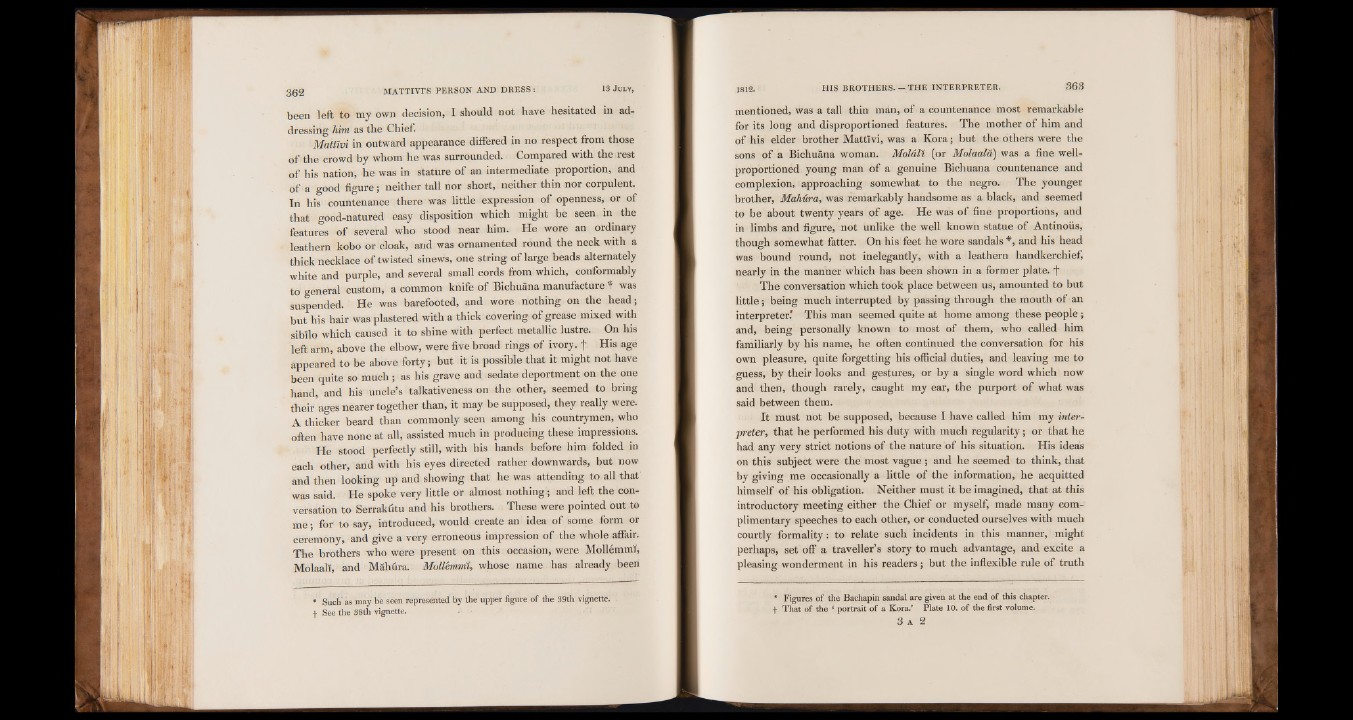
been left to my own decision, I should not have hesitated in addressing
him as the Chief.
Mattivi in outward appearance differed in no respect from those
of the crowd by whom he was surrounded. Compared with the rest
of his nation, he was in stature of an intermediate proportion, and
of a good figure; neither tall nor short, neither thin nor corpulent.
In his countenance there was little expression of openness, or of
that good-natured easy disposition which might be seen, in the
features of several who stood near him. He wore an ordinary
leathern kobo or cloak, and was ornamented round the neck with a
thick necklace of twisted sinews, one string of large beads alternately
white and purple, and several small cords from which, conformably
to general custom, a common knife of Bichuana manufacture $ was
suspended. He was barefooted, and wore nothing on the head;
but his hair was plastered with a thick covering of grease mixed with
sibilo which caused it to shine with perfect metallic lustre. On his
left arm, above the elbow, were five broad rings of ivory, f His age
appeared to be above forty; but it is possible that it might not have
been quite so much; as his grave and sedate deportment on the one
hand, and his uncle’s talkativeness on the other, seemed to bring
their ages nearer together than, it may be supposed, they really were.
A thicker beard than commonly seen among his countrymen, who
often have none at all, assisted much in producing these impressions.
He stood perfectly still, with his hands before him folded in
each other, and with his eyes directed rather downwards, but now
and then looking up and showing that he was attending to all that
was said. He spoke very little or almost nothing; and left the conversation
to Serrakutu and his brothers. These were pointed out to
me; for to say, introduced, would create an idea of some form or
ceremony; and give a very erroneous impression of the whole affair.
The brothers who were present on this occasion, were MollemmJ,
Molaall, and Mahura. Mollernmi, whose name has already been
* Such' as may be seen represented by the upper figure of the S9lh vignette,
f See the S8th vignette.
mentioned, was a tall thin man, of a countenance most remarkable
for its long and disproportioned features. The mother of him and
of his elder brother Mattivi, was a Kora; but the others were the
sons of a Bichuana woman. Molatt (or Molaald) was a fine well-
proportioned young man of a genuine Bichuana countenance and
complexion, approaching somewhat to the negro. The younger
brother, Mahura, was remarkably handsome as a black, and seemed
to be about twenty years of age. He was of fine proportions, and
in limbs and figure, not unlike the well known statue of Antinoiis,
though somewhat fatter. On his feet he wore sandals *, and his head
was bound round, not inelegantly, with a leathern handkerchief,
nearly in the manner which has been shown in a former plate, f
The conversation which took place between us, amounted to but
little; being much interrupted by passing through the mouth of an
interpreter.’ This man seemed quite at home among these people;
and, being personally known to most of them, who called him
familiarly by his name, he often continued the conversation for his
own pleasure, quite forgetting his official duties, and leaving me to
guess, by their looks and gestures, or by a single word which now
and then, though rarely, caught my ear, the purport of what was
said between them.
It must not be supposed, because I have called him my interpreter,
that he performed his duty with much regularity; or that he
had any very strict notions of the nature of his situation. His ideas
on this subject were the most vague ; and he seemed to think, that
by giving me occasionally a little of the information, he acquitted
himself of his obligation. Neither must it be imagined, that at this
introductory meeting either the Chief or myself, made many complimentary
speeches to each other, or conducted ourselves with much
courtly formality: to relate such incidents in this manner, might
perhaps, set off a traveller’s story to much advantage, and excite a
pleasing wonderment in his readers; but the inflexible rule of truth
* Figures of the Bachapin sandal are given at the end of this chapter,
f That of the 4 portrait of a Kora.’ Plate 10. of the first volume.